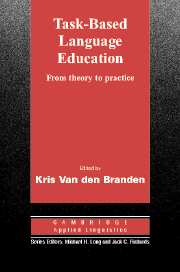Book contents
- Frontmatter
- Contents
- Acknowledgements
- Series Editors' Preface
- Chapter 1 Introduction: Task-based language teaching in a nutshell
- Chapter 2 From needs to tasks: Language learning needs in a task-based approach
- Chapter 3 Tasks for absolute beginners and beyond: Developing and sequencing tasks at basic proficiency levels
- Chapter 4 Developing language tasks for primary and secondary education
- Chapter 5 Task-based language teaching in science education and vocational training
- Chapter 6 Task-based language teaching and ICT: Developing and assessing interactive multimedia for task-based language teaching
- Chapter 7 Developing and introducing task-based language tests
- Chapter 8 The role of the teacher in task-based language teaching
- Chapter 9 A box full of feelings: Promoting infants' second language acquisition all day long
- Chapter 10 Training teachers: Task-based as well?
- References
- Subject Index
- Name Index
Chapter 2 - From needs to tasks: Language learning needs in a task-based approach
Published online by Cambridge University Press: 05 May 2010
- Frontmatter
- Contents
- Acknowledgements
- Series Editors' Preface
- Chapter 1 Introduction: Task-based language teaching in a nutshell
- Chapter 2 From needs to tasks: Language learning needs in a task-based approach
- Chapter 3 Tasks for absolute beginners and beyond: Developing and sequencing tasks at basic proficiency levels
- Chapter 4 Developing language tasks for primary and secondary education
- Chapter 5 Task-based language teaching in science education and vocational training
- Chapter 6 Task-based language teaching and ICT: Developing and assessing interactive multimedia for task-based language teaching
- Chapter 7 Developing and introducing task-based language tests
- Chapter 8 The role of the teacher in task-based language teaching
- Chapter 9 A box full of feelings: Promoting infants' second language acquisition all day long
- Chapter 10 Training teachers: Task-based as well?
- References
- Subject Index
- Name Index
Summary
In this chapter, we will focus on tasks as attainment goals (see also Chapter 1 in this volume). Determining and describing target tasks may be regarded as the first step in the process of task-based curriculum design (Long, 1985, 1997, 2005a; Richards, 2001). In describing target tasks for language education and evaluation, a balance will need to be struck between theoretical principles and practicability. What can be argued for theoretically may not always be realizable in real-life language education or assessment. How to deal with practicalities in applying the task-based approach to the description of target tasks will therefore be one of the key issues dealt with in this chapter.
Language learning needs from a societal perspective
When it comes to curriculum design for second language education, two basic questions are usually asked by teachers and syllabus designers: ‘What should language learners learn?’ and ‘How can language learners be stimulated to learn whatever they are supposed to learn?’ A third question which may be equally important from the learners' point of view, but which is very often overlooked except in the field of language education for specific purposes, is: ‘Why?’
Why do so many people all over the world go through the trouble of enrolling in second language courses, buying dictionaries and grammars, spending hours practising grammar rules, experimenting with new sounds and new words, acquiring new orthographic systems and taking nerve-racking exams?
Information
- Type
- Chapter
- Information
- Task-Based Language EducationFrom Theory to Practice, pp. 17 - 46Publisher: Cambridge University PressPrint publication year: 2006
Accessibility standard: Unknown
Why this information is here
This section outlines the accessibility features of this content - including support for screen readers, full keyboard navigation and high-contrast display options. This may not be relevant for you.Accessibility Information
- 25
- Cited by
